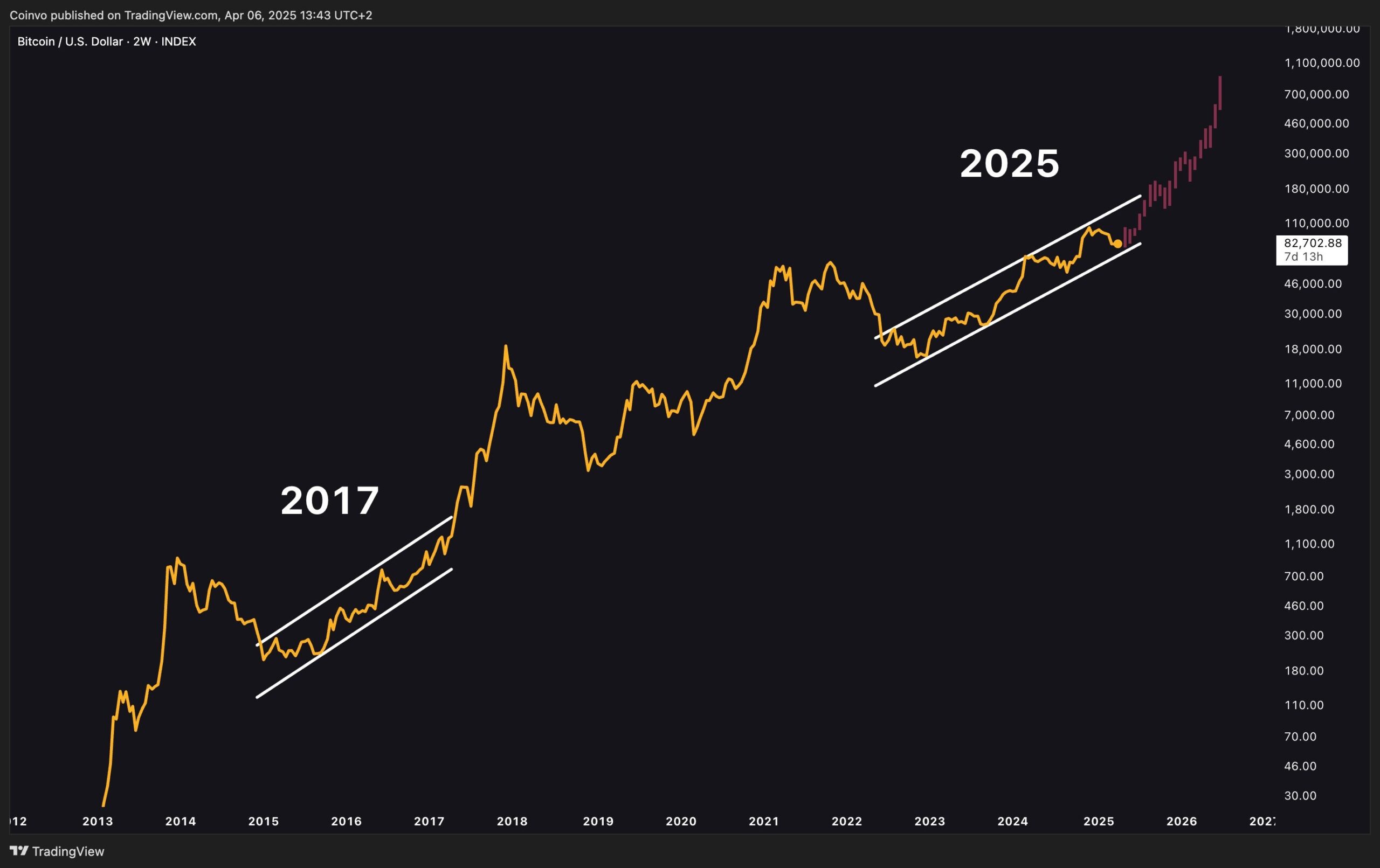Introduction
After demonstrating remarkable resilience during last week’s global market volatility, cryptocurrencies have finally succumbed to the broader sell-off pressure sweeping financial markets worldwide. Bitcoin, the world’s largest cryptocurrency by market capitalization, along with other major digital assets, has experienced significant price declines as investor sentiment turns increasingly risk-averse amid mounting economic uncertainties.
This shift marks a notable departure from cryptocurrencies’ recent performance pattern, where they had maintained relative stability while traditional equity and bond markets experienced substantial fluctuations. The latest downturn challenges the emerging narrative of Bitcoin as a potential “digital gold” or safe haven asset during periods of market stress, and raises questions about the correlation between cryptocurrency markets and conventional financial systems.
This article examines the current cryptocurrency market downturn, analyzes the factors contributing to this shift, explores the broader market context, and considers potential implications for investors and the future of digital assets in the global financial ecosystem.
Current Market Situation
Bitcoin’s Price Movement
Bitcoin, which had been trading within a relatively narrow range despite the turbulence in global markets last week, has experienced a sharp decline in the past 24-48 hours. After maintaining positions around the $65,000-$68,000 level throughout much of the recent market volatility, Bitcoin has dropped below the critical $60,000 support level, marking a decline of approximately 10-15% from recent highs.
This downward movement represents one of the more significant corrections since Bitcoin’s impressive rally earlier this year, which saw the cryptocurrency reach all-time highs above $73,000 following the approval of spot Bitcoin ETFs in the United States and anticipation of the Bitcoin “halving” event.
Altcoin Performance
The sell-off has been even more pronounced across the broader cryptocurrency market, with many alternative cryptocurrencies (altcoins) experiencing deeper corrections:
- Ethereum (ETH), the second-largest cryptocurrency, has fallen approximately 15-20%, dropping below the $3,000 level that had served as a psychological support zone.
- Solana (SOL), Cardano (ADA), and Polkadot (DOT) have seen declines of 20-25%, erasing significant gains accumulated during the previous bullish phase.
- Meme coins such as Dogecoin (DOGE) and Shiba Inu (SHIB) have experienced particularly steep drops, with some declining by over 30%, highlighting their heightened volatility during market stress.
Market Metrics
The cryptocurrency market capitalization has contracted by approximately $300-400 billion during this sell-off, with total market value falling below $2.2 trillion. Trading volumes have surged across major exchanges, indicating heightened activity as investors reposition portfolios amid the changing market dynamics.
Market sentiment indicators, including the Crypto Fear & Greed Index, have shifted from “Greed” territory into “Fear” or even “Extreme Fear,” reflecting the rapidly changing investor psychology. Liquidations of leveraged positions have accelerated the price decline, with over $1 billion in long positions reportedly liquidated within a 24-hour period.
Contributing Factors to the Cryptocurrency Sell-Off
Integration with Global Financial Markets
The current sell-off indicates that cryptocurrencies have become increasingly integrated with broader financial markets, contrary to the decoupling narrative that had gained traction earlier in the year. Several factors explain this growing correlation:
- Institutional Participation: The increased presence of institutional investors in cryptocurrency markets has strengthened the linkage between digital assets and traditional financial systems. These institutional players often manage cryptocurrency positions as part of diversified portfolios, making them subject to similar risk management considerations as other asset classes.
- Macro Economic Influences: Cryptocurrencies have become more sensitive to macroeconomic factors, including inflation expectations, central bank policies, and economic growth projections—the same factors that drive movements in stocks, bonds, and commodities.
- Liquidity Conditions: Global liquidity conditions now impact cryptocurrency markets similarly to other financial assets, with tightening liquidity environments typically resulting in reduced risk appetite across all speculative investments.
Recent Market Triggers
Several specific catalysts appear to have contributed to the current cryptocurrency market correction:
- Global Risk Reassessment: Growing concerns about global economic growth, particularly signs of slowdown in major economies including the United States and China, have prompted investors to reduce exposure to perceived high-risk assets.
- Monetary Policy Uncertainty: Shifting expectations regarding central bank policies, particularly the pace and extent of interest rate adjustments by the Federal Reserve and other major central banks, have increased market volatility across asset classes.
- Technical Factors: Bitcoin’s failure to sustain momentum above key resistance levels despite seemingly positive fundamental developments (like ETF inflows) has triggered technical selling pressures.
- Profit-Taking: Following substantial gains earlier in the year, some investors appear to be securing profits, particularly as global economic uncertainty increases.
Cryptocurrency-Specific Issues
In addition to broader market influences, several cryptocurrency-specific factors have contributed to the current sell-off:
- Regulatory Developments: Ongoing regulatory scrutiny in major markets, including recent enforcement actions and policy discussions in the United States, European Union, and Asia, has created uncertainty about the future operating environment for cryptocurrency businesses.
- Post-Halving Dynamics: Bitcoin’s recent halving event, which reduced mining rewards, has historically been followed by periods of price consolidation or correction before new uptrends emerge.
- Exchange Outflows: Data from cryptocurrency exchanges showed significant outflows prior to the current correction, potentially indicating that some large holders were reducing positions.
- DeFi and NFT Market Cooling: Declining activity in decentralized finance (DeFi) protocols and non-fungible token (NFT) marketplaces has reduced speculative interest in tokens associated with these sectors.
Context: Global Market Turmoil
The cryptocurrency sell-off occurs against a backdrop of significant volatility across global financial markets:
Equity Markets
Major stock indices worldwide have experienced substantial declines. The S&P 500, Nasdaq Composite, and Dow Jones Industrial Average have all witnessed corrections, with technology stocks particularly hard-hit. Similarly, European and Asian equity markets have recorded significant losses as investors reassess growth prospects and risk exposures.
The CBOE Volatility Index (VIX), often referred to as the “fear gauge” for the stock market, has surged to levels not seen since early pandemic periods, indicating heightened investor anxiety.
Bond Markets
Government bond yields have fluctuated dramatically, reflecting changing expectations about inflation, economic growth, and monetary policy. The U.S. Treasury market has seen particularly volatile trading as investors attempt to price in future Federal Reserve actions.
Credit spreads have widened, indicating growing concerns about corporate debt and potential economic difficulties ahead. The fixed-income market volatility has disrupted traditional asset allocation strategies and contributed to broader market uncertainty.
Commodities and Currencies
Traditional safe-haven assets like gold have shown mixed performance during the recent turmoil. While gold initially strengthened, it has not been immune to selling pressure in certain sessions, highlighting the complex dynamics at play.
The U.S. dollar has generally strengthened against other major currencies during the market turbulence, reflecting its status as a reserve currency and safe-haven asset during periods of global uncertainty.
Implications and Analysis
Changing Narrative Around Cryptocurrencies
The current sell-off challenges several prevailing narratives about cryptocurrencies:
- Safe Haven Status: Bitcoin’s inability to maintain stability during this broader market turmoil weakens the argument that it functions as a reliable safe-haven asset or “digital gold” during periods of financial stress.
- Inflation Hedge: The cryptocurrency market decline amid ongoing inflation concerns undermines the proposition that digital assets serve as effective inflation hedges.
- Decoupling Theory: The synchronization of cryptocurrency declines with broader market movements contradicts the idea that digital assets operate independently of traditional financial systems.
However, it’s important to note that market narratives evolve over time, and the current period of correlation doesn’t necessarily invalidate longer-term potential for different market dynamics.
Institutional Investor Perspective
For institutional investors engaged in cryptocurrency markets, the current downturn presents both challenges and opportunities:
- Risk Management: The volatility reinforces the need for robust risk management frameworks when allocating to digital assets, potentially leading to more sophisticated approaches to cryptocurrency portfolio construction.
- Valuation Reassessment: The correction offers an opportunity to reassess fundamental valuation models for cryptocurrencies, particularly as the market matures and new use cases develop.
- Regulatory Preparation: Market stress periods often accelerate regulatory developments, encouraging institutional participants to prepare for potential changes in the regulatory landscape.
- Strategic Positioning: For institutions with long-term conviction in blockchain technology and digital assets, the market decline may present strategic entry points, provided they have adequate risk controls in place.
Technical Market Outlook
From a technical analysis perspective, several key factors will likely influence the cryptocurrency market’s near-term trajectory:
- Support Levels: Market participants are closely monitoring whether Bitcoin can maintain support around the $55,000-$58,000 range, which represents significant previous resistance turned support levels.
- Volume Patterns: Declining volumes during any recovery attempts would suggest limited conviction, while increasing volumes would indicate stronger market participation.
- Market Structure: The preservation or breakdown of the broader uptrend structure that has been in place since late 2023 will be crucial for determining medium-term price direction.
- Futures Market Positioning: The positioning of futures traders, particularly the balance between leveraged long and short positions, will influence market volatility and potential price movements.
Future Outlook and Considerations
Short-Term Scenarios
Looking ahead, several potential scenarios could unfold in the cryptocurrency market:
- Continued Correlation with Risk Assets: If global market volatility persists, cryptocurrencies may continue to move in tandem with other risk assets, potentially experiencing further downside if broader market sentiment deteriorates.
- Stabilization and Divergence: Alternatively, cryptocurrencies could stabilize at technical support levels and begin to diverge from broader market trends, particularly if crypto-specific positive catalysts emerge.
- Liquidity-Driven Volatility: Regardless of direction, market liquidity conditions will likely continue to influence price action, with the potential for sharp moves in either direction as liquidity ebbs and flows.
Medium-Term Market Dynamics
Several factors will shape the cryptocurrency market over the coming months:
- ETF Flows: The ongoing adoption and capital flows into spot Bitcoin ETFs will influence market dynamics, with consistent inflows potentially providing price support despite broader market volatility.
- Regulatory Developments: Anticipated regulatory decisions, particularly in the United States, European Union, and major Asian markets, will significantly impact market sentiment and institutional participation.
- Technological Advancements: Progress in scalability solutions, layer-2 networks, and real-world blockchain applications could alter the fundamental value proposition of various cryptocurrencies.
- Macroeconomic Environment: The evolution of inflation, interest rates, and economic growth globally will continue to influence risk appetite for digital assets.
Investment Considerations
For investors navigating the current cryptocurrency market environment, several considerations merit attention:
- Time Horizon Alignment: The heightened volatility underscores the importance of aligning investment time horizons with risk tolerance, with shorter time horizons warranting more conservative approaches.
- Diversification Benefits: Despite the recent correlation with other risk assets, cryptocurrencies may still offer portfolio diversification benefits over longer time frames due to their distinct fundamental drivers.
- Fundamental Analysis: Market corrections provide opportunities to reassess the fundamental value propositions of various blockchain projects and cryptocurrencies, potentially identifying those with sustainable long-term potential.
- Risk Management Discipline: The implementation of consistent risk management practices, including position sizing, stop-loss strategies, and portfolio rebalancing, becomes even more critical during periods of elevated market volatility.
Conclusion
The current cryptocurrency market downturn, occurring against the backdrop of broader global financial market turmoil, represents a significant test for digital assets that had previously demonstrated relative resilience. This synchronization of cryptocurrency price movements with traditional market volatility challenges certain narratives about Bitcoin and other digital assets, while reinforcing the growing integration of cryptocurrencies into the global financial ecosystem.
While short-term price action may continue to be influenced by broader risk sentiment and liquidity conditions, the longer-term trajectory of cryptocurrencies will likely be determined by a combination of technological advancement, regulatory developments, institutional adoption, and evolving use cases. For investors and market participants, the current volatility presents both challenges and opportunities, emphasizing the importance of well-defined investment strategies, risk management discipline, and a clear understanding of the evolving role of digital assets in diversified portfolios.
As markets navigate this period of uncertainty, the cryptocurrency sector’s response to these challenges will provide valuable insights into its maturation process and long-term position within the global financial landscape. Whether digital assets eventually return to demonstrating independent market behavior or continue to correlate with traditional financial markets will be a key question for investors and analysts in the months ahead.





